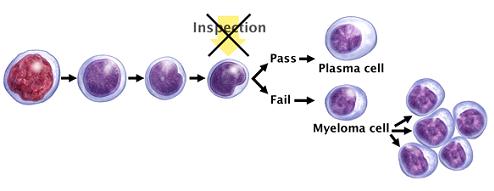Multiple Myeloma
Home > Clinical Concepts In Radiation Oncology > Anatomy, Physiology > Miscellaneous > Multiple Myeloma
Can we please get your advice on this one question?
Multiple Myeloma is one type of cancer that develops in the bone marrow. Bone marrow is a soft, spongy found inside the bone. It helps in making red blood cells.

Figure shows the origin of multiple myeloma (bone marrow).
Symptoms:
The most commonly observed symptoms are listed below,
Reduction in RBC (anaemia)
Bone pain
Bleeding problems
Brittle bones are more likely to break
Fatigue due to anaemia
Fever without any other cause
Shortness of breath
Renal failure
Neurological symptoms
The process of production of myeloma cells are shown schematically in the diagram below.

Diagnosis:
Blood tests of the following substances in the body are important to measure to confirm the disease.
1. Calcium level
2. Albumin level
3. Kidney performance level
4. Total protein level
5. Complete blood count
6. Urine and blood tests to identify the proteins or antibodies
7. Immunoglobulins level
Treatment:
People who have mild disease or where the diagnosis is not certain are often closely watched without treatment. Some people have a slow-developing form of multiple myeloma that takes years to cause symptoms.
Medications for the treatment of multiple myeloma include:
Dexamethasone, melphalan, cyclophpshamide,dosorubicin, thalidomide,lenalidomide (Revlimid),and bortezomib (Velcade) can be used alone or combined together.
Bisphosphonates (pamidronate or zoledronic acid) to reduce bone pain and prevent fractures.
Radiation therapy may be done to get rid of bone pain or treat a bone tumour
Two types of bone marrow transplantation may be tried:
Autologous bone marrow or stem cell transplantation makes use of one’s own stem cells.
Allogeneic transplant makes use of someone else stem cells. This treatment carries serious risks but offers the chance of improved survival.
A recent study shows the survival rates of multiple myeloma are on an average of two to four years.
People with multiple myeloma should drink plenty of fluids to prevent dehydration and help maintain proper kidney function. They should also be cautious when having x-ray tests that use contrast dye.
Questions:
1. Symptoms of multiple myeloma are
a) Bone pain
b) Increase in calcium level
c) Albumin level
d) All
2. The survival rates for multiple myeloma is on an average of,
a) One year
b) Two to four years
c) Two to ten years
d) All
Answer:
1. d) All
2. b) Two to four years
References:
1. http://www.ncbi.nlm.nih.gov
4. http://mymultiplemyeloma.com
Home > Clinical Concepts In Radiation Oncology > Anatomy, Physiology > Miscellaneous > Multiple Myeloma
FREE Infographic What successful people believe. What successful people do
Dictionary of Cancer Terms
Need help understanding a word? Here is an electronic resource that gives meaning to Cancer terms and their usage.

StrengthsFinder 2.0